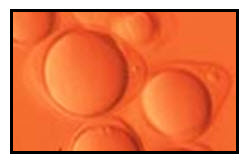How Does Thermochromic Ink Work?
Let’s start with the term thermochromic, which describes the ability of something to change color with changes in the temperature. Thus, when thermochromic ink is used on a material, the part where the ink is will change colors with fluctuations in temperature.
So how do thermochromic inks change color?
Thermochromic ink contains leuco dye. Leuco dyes can acquire two different molecular forms: a colorless form and a colored form. At warm temperatures, the thermochromic ink is colorless, and at cold temperatures, the thermochromic ink is colored.
The simple explanation is that when colorless, the form of the leuco dye molecules are transparent to visible light, meaning that visible light passes through them. When colored the form of the leuco dye molecules absorbs part of the visible light spectrum and reflect what has not been absorbed. The reflected light is what gives the dye its color.
But what is actually happening to cause the color change?
The physical changes in the structure of leuco dyes is in response to changes in the pH, which is a scale that measures the acid and basic properties. When the pH is low, the structure of the leuco dye molecules is more open and absorbs and reflect visible light. Thus the dye is colored. At a high pH the leuco dye molecules have a more closed shape and are transparent to visible light. Dyes that change color in response to changes in ph are said to be halochromic.
The diagram shows microcapsules from 1 to 10 microns in diameter. The capsules have a very thin outer wall that hold the the leuco dye, a weak acid and a solvent. The leuco dye used depends on the color desired. The solvent used depends on the temperature at which a color change is desired.
Let’s Sum It UP!
All thermochromic inks are colored at cool temperatures and colorless at elevated temperatures.
At a cool temperature the solvent inside the microcapsules is in the solid state, the leuco dye and weak acid are in contact with each other and the dye molecules are colored. In the liquid state, the dye and acid component disperse and the colorless form of the dye predominates.
Uses for Thermochromic Inks:
- Thermochromic inks are used on labels of microwaveable foods, such some syrup bottles. The thermochromic ink is black when cool, thus covers the red print it covers. When heated, the ink is transparent, thus the word HOT printed in red ink is visible. As the ink cools it again turns black. Thus, the ink is reversible.
- Color changing fabric used to make clothes, generally T-Shirt style.
- Paint for vehicles that change color in response to air temperature.

• A two-toned effect can be created by mixing a colored thermochromic ink with another colorant, such as acrylic paint. Mixing a blue thermochromic ink with a yellow paint results in a layer that appears green at low temperatures and yellow at elevated temperatures.
For more information about mixtures of thermochromic ink with acrylic paint, click Here
Adding Rigor:
The part of the leuco dye molecule that changes is called the chromophore.
Find out about chromophores and how the section of a leuco dye molecules determines the color of the dye.
(paid link)

